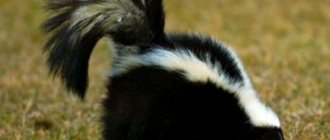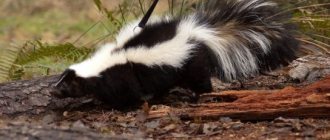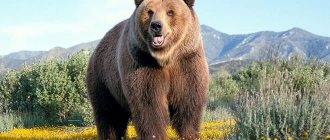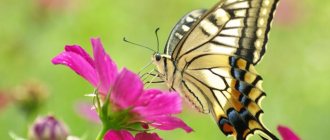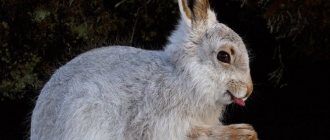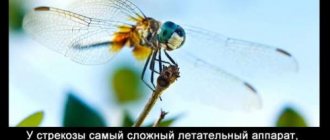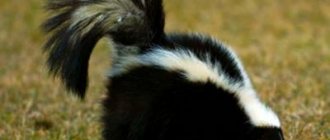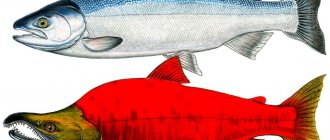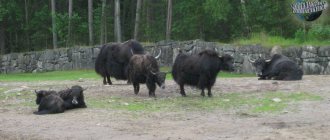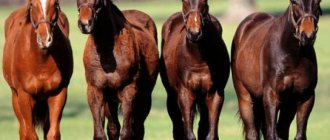Striped skunks are the most common and recognizable species.
When people think of a skunk, they think of a striped skunk. It is found throughout the United States and Canada. These small animals weigh on average about 2.7 kg, but the body weight of some individuals reaches 7.2 kg.
Individuals are typically black, with a bright white patch that begins on the top of the head, splits into two stripes on the shoulders, and merges again into a single stripe at the tip of the tail. Markings vary greatly among populations. Striped skunks can have three or more stripes and range in color from solid black to completely white.
Striped skunks are true ground dwellers and cannot climb trees at all.
Reproduction
Skunks are polygamous animals; one male, as a rule, has sexual intercourse with several females, thus creating a small animal harem. The mating season for skunks begins in early spring, and by mid-summer, after a short pregnancy, females give birth to cubs. Usually, on average, one skunk mother gives birth to 6 to 10 babies. Little skunks, like kittens, are born blind and only after a week their eyes begin to open. At first they are completely helpless and are completely dependent on their mother, who feeds them milk. Then the babies begin to quickly grow and get stronger, and by four months they already pose a serious “odorous” danger to others.
Hog-nosed skunks are the largest in the family.
Hog-nosed skunks are typically brown and white in color. They have a well-developed snout, which allows them to dig out insects and spiders from dry soil. Hog-nosed skunks are more mobile than other species. They regularly climb rocky slopes and enter caves filled with bats, their favorite delicacies.
Photo: www.animals.sandiegozoo.org
Spotted skunks are the smallest species
Their weight varies from 200 grams to 1 kg. This is the complete opposite of other types of skunks: they not only climb trees, but also destroy bird nests. Spotted skunks sleep in earthen burrows. They are the most elusive and secretive of the skunk species, but also the most social, sometimes living together in groups of 5 or more.
When threatened, the tiny spotted skunk will do a handstand, raising its tail and legs upward in an attempt to appear larger. He will walk like this on his front paws for several minutes, hoping that the enemy will get scared and leave.
Classification [edit]
Main article: List of Mephitids
In alphabetical order, living skunk species include:[32]
Skunk skeleton with hood on display at the Museum of Osteology
- Family Mephitidae
Genus:
Conepatus Conepatus chinga
- Molina's pig-nosed skunk - Conepatus humboldtii
- Humboldt Skunk - Conepatus leuconotus
- American pig-nosed skunk - Conepatus semistriatus
- striped pig nose
- Mephitis macroura
- hooded skunk
- striped skunk
- Spilogale angustifrons
- southern spotted skunk
- western spotted skunk
- eastern spotted skunk
- pygmy spotted skunk
Skunks are crepuscular animals
They are most active at dusk and dawn and sleep in nests or burrows during the day. Skunks spend most of their time hunting for prey.
Skunks are omnivores. They have large, sharp teeth and extremely long, curved claws. Their diet is primarily insectivorous during the spring and summer seasons, when grasshoppers, beetles, crickets, bees and other arthropods are abundant, and they switch to a carnivorous diet in the colder months. Throughout the winter they eat small mammals, chicks, eggs, amphibians, reptiles and fish.
Photo: www.animals.sandiegozoo.org
Nutrition
The skunk does not know how to catch fast or large prey; it does not have the necessary abilities for this. Therefore, its diet includes small rodents, lizards, and frogs. If it happens, he may attack helpless bunnies.
It also feeds on carrion. The mammal's diet is varied. In summer, he can feast on fruits and wild berries, as well as seeds and grass. The menu depends on the season. In winter by animals, and with the onset of warmth by vegetation.
The predator mainly goes out hunting at night. His vision is weak even during the day, so at night he uses his hearing and smell. With its nose and paws, the skunk digs into the ground in search of insects. Turns over fallen bark and rocks in search of lizards.
Small rodents, the skunk stretches out, waits, and then leaps, capturing the prey with its paws and teeth. Similar tactics for hunting grasshoppers and beetles. Only in this case does he press the insects to the ground with his paws.
The animal rolls some on the ground in order to remove, for example, the poisonous skin of a toad or remove the prickly fibers of caterpillars. To avoid being caught by a skunk, he eats it on the spot. It periodically catches coprophages in its own feces. These mammals love honey very much. But if they come across a hive, it will eat everything, honeycombs, bees, and honey.
A bee sting is not painful for him, and his thick, hard fur protects him from stings. The only weak point is the muzzle. Eggs are also one of his delicacies. To break it, the skunk throws them back under itself, in the hope that the egg will bump into something hard and break. At home, to feed a skunk the same way as a dog.
He needs the following diet: not spicy, not salty, not sweet, not fatty. You can give all vegetables and fruits; there should be at least 50% of them in the menu. For proteins, give boiled fish or chicken. Eggs, rice, millet and other grains should be constantly included in the diet. Like all animals, skunks eat only natural products.
Preservatives are poison for them. In agriculture, they bring considerable benefit by eating rodents and insects that harm the crop. Rarely, these mammals can eat carrots or beets from the garden.
Dangerous opponent
The stripes on the fur serve as a warning to predators to stay away, and for the most part they do. Only inexperienced animals will encroach on their territory. Skunks typically only attack when cornered or defending their young, and spraying is not their first defense. The skunk will growl, spit, ruffle its fur, shake its tail, and stomp its feet. If the aggressor does not heed the warnings, the skunk will raise its tail and spray its famous scent.
Like tear gas, skunks' anal discharge not only causes harm, but also burns the mucous membranes of unfortunate victims. The victim may experience severe discomfort, pain, difficulty breathing and even temporary blindness. The odor will linger on hair, clothing, fur, skin and the environment for days to weeks and can be smelled more than 1.5 km away.
Most animals, be it mountain lions, bear cubs or young coyotes, will never risk contact with a skunk again after being sprayed, and their distinctive coloring allows victims to remember and avoid skunks in the future. The only creature that regularly hunts them is the great horned owl. For some reason she is not deterred by the smell and burning sensation.
Skunks' two grape-sized anal glands contain a total of about 4 tablespoons of fluid. It can take several days to replenish them, so skunks will only spray if there is real danger, because without this protection they become helpless against large predators.
Enemies
On the American continent, where the skunk lives, it has practically no enemies among mammals. Due to inexperience, young predatory animals can attack him: foxes, coyotes, cougars, however, having received a “stinking shot” right in the nose, they will not do this again.
But skunks have enemies among birds of prey. These include Virginia eagle owls, red-tailed buzzards, and Jamaican buzzards, which do not have a good sense of smell, and therefore the secretions secreted by skunks are not terrible for them. They dive from a height onto the animal and cling to its back with their claws, so that it becomes completely helpless and is unable to use its defense.
When in the USSR in the 1930s, scientists attempted to resettle these animals and acclimatize them on the European mainland, where a similar climate exists for skunks to live, local predators quickly destroyed them. They were not familiar with their protective device, and therefore were not afraid.
Great opportunist
Skunks are extremely adaptable and thrive in a wide variety of habitats as long as food and shelter are available. Because skunks rarely travel more than 3 km from their established dens, they choose sites located within 3 km of a water source.
Photo: www.animals.sandiegozoo.org
Dens are made in hollow trees, hollowed out logs, bushes, abandoned animal holes, as well as under porches and other structures. Skunks sometimes dig burrows underground if there are no other shelter options.
Skunks are solitary animals
They make regular rounds of their territory, which is usually about 2.5 square meters. km. However, skunks are not territorial and are not aggressive towards their fellows, with the exception of small skirmishes over food or a den. These encounters rarely result in actual confrontation and almost never involve spraying except during mating.
One skunk can have up to ten burrows, distributed throughout its range. He uses his most secret and well-protected lair in winter. Skunks do not hibernate, but in areas where temperatures drop below freezing in the winter, they enter a state of torpor, light sleep with a decreased metabolism and slightly lower body temperature.
Cultural aspects[edit]
Etymology[edit]
The word "reptile" is an Americanism from 1630, Massachusetts Reflex (linguistics) from Proto-Algonquian squunck, from Southern New England Algonquian language (probably Abenaki) seganku, from Proto-Algonquian */seka: kva/, with */šek-/" urinate" + * / - a: kw / "fox".
Slang [edit]
"Skunk" has been historically used as an insult, attested since 1841[5]
History of European consciousness [edit]
In 1634, the skunk was described in the "Relations of the Jesuits"
:
The other is a short animal about the size of a dog or cat. I mention it here not because of its superiority, but to make it a symbol of sin. I saw three or four of them. He has black fur, quite beautiful and shiny; and has on the back two completely white stripes, which join near the neck and tail, forming an oval, which greatly enhances their grace. The tail is thick and well-furred, like that of a fox; he carries it curled back like a squirrel. It is more white than black; and at first sight you might say, especially as he walks, that he should be called the little dog of Jupiter. But she is so stinking and exudes such a disgusting odor that she is not worthy to be called Pluto's dog. No sewer ever smelled so bad. I wouldn't have believed it if I hadn't smelled it myself. Your heart almost gives out when you get close to an animal; two were killed in our court, and a few days later there was such a terrible smell in our house that we could not bear it. I believe that sin smells like Saint Catherine of Sienna must have had the same vile smell. [6]
In Southern US dialect, the term ferret
sometimes used as a colloquial nickname for a skunk. [7]
Skunks are polygamous animals
The breeding season begins in mid-February and ends in mid-April. The male and female may have multiple partners over the course of several days or weeks.
If a female becomes pregnant early in the season, the development of fertilized eggs may be delayed for several weeks. Delayed implantation, lasting up to 19 days, ensures that young will be born in warmer months when food is more plentiful.
The gestation period lasts from 59 to 77 days. The female gives birth to 2 to 8 cubs. Newborn skunks are naked and blind, although their skin already has a slightly visible striped pattern. They are able to spray at about 3-4 weeks - right around the time their eyes open.
Photo: www.animals.sandiegozoo.org
The female will begin to leave the den when the cubs are 6 weeks old. They follow her in single file and tend to maintain skin-to-skin contact with each other. The hatchlings make a lot of squeaking and gurgling noises to communicate, and it may seem like one big furry animal is moving. The young begin to hunt on their own after about 2 months.
Links[edit]
- "Old World Skunk". Retrieverman.net
. November 2, 2015. Retrieved December 13, 2022. - "skunk noun - Definition, pictures, pronunciation and usage notes - Oxford Advanced Learner's Dictionary". Oxfordlearners Commandaries.com
. Retrieved December 13, 2022. - "SKUNK - meaning in the Cambridge English Dictionary". dictionary.cambridge.org
. Retrieved December 13, 2022. - "skunk - meaning of skunk in the Longman Dictionary of Contemporary English - LDOCE". Ldoceonline.com
. Retrieved December 13, 2022. - Harper, Douglas. "skunk". Online Dictionary of Etymology
. - Thwaites, Reuben Gold, ed. (1633–1634). Jesuit relations and union documents. Travels and Explorations of Jesuit Missionaries in New France 1610–1791. VI
. Quebec. Archived from the original on December 15, 2001. - "Skunk Newsletter" (PDF). Georgia Department of Natural Resources
. - ^ ab ADW: Mephitis mephitis: INFORMATION. animaldiversity.ummz.umich.edu. Retrieved April 5, 2012.
- ^ ab Virtual nature trail. Striped skunk. Pennsylvania State University (2002).
- "Skunk Management Tips". Ipm.ucdavis.edu
. - "Eastern Spotted Skunk". Missouri Department of Conservation
. Retrieved February 23, 2022. - "Ask the Bear: Skunk Spray as a Deterrent?" .
- Darwin, Charles (1839). Voyage of the Beagle. London, England: Penguin. ISBN 0-14-043268-X. Source +27 June 2006.
- Skunk Biology and Control. Agriculture and rural development. Government of Alberta, Canada. June 1, 2002
- "Oregon Zoo Animals: Great Horned Owl". Oregonzoo.org
. Archived from the original on March 19, 2012. Retrieved February 9, 2012. - "Great Horned Owl". Cornell Lab of Ornithology. Archived from the original on July 5, 2022. Retrieved March 21, 2013.
- Hunter, Luke (2011). Carnivores of the World
.
Princeton, NJ: Princeton University Press. ISBN 978-0-691-15228-8.[ page required
] - Is it true that tomato sauce will get rid of skunk smell? . Scienceline. Retrieved April 5, 2012.
- "Removing Your Dog's Skunk". Humane Society of the United States.
- Andersen KK; Bernstein D.T. (1978). "Some Chemical Constituents of the Striped Skunk ( Mephitis mephitis
) Odor".
Journal of Chemical Ecology
.
1
(4):493–499. DOI: 10.1007/BF00988589. - Andersen KK; Bernstein D.T. (1978). "1-Butanethiol and the striped skunk." Journal of Chemical Education
.
55
(3): 159–160. Bibcode: 1978JChEd..55..159A. DOI: 10.1021/ed055p159. - Andersen KK; Bernstein D.T.; Caret RL; Romanchik, L. J., Jr. (1982). "Chemical constituents of the protective secretions of the striped skunk ( Mephitis mephitis
)".
Tetrahedron
.
38
(13): 1965–1970. DOI: 10.1016/0040-4020 (82) 80046-X. - WF tree; Sollers BG; Dragoo GA; Dragoo JW (2002). "Volatile components in the protective spray of the hooded skunk, Mephitis macroura
."
Journal of Chemical Ecology
.
28
(9): 1865–70. DOI: 10.1023/A: 1020573404341. PMID 12449512. - Wood, William F. "The Chemistry of Skunk Spray". Department of Chemistry, Humboldt State University. Retrieved July 27, 2010.
- Wood, William F. (1999). "History of Research into the Skunk's Defensive Secretions" (PDF). Chem.
Educator .
4
(2): 44–50. DOI: 10.1007/s00897990286a. Archived from the original (PDF) on September 2, 2003. - Jump up
↑ Aldrich, T. B. (1896).
"A Chemical Study of the Secretion of the Anal Glands of the Mephitica mephitica (Common Skunk), with Remarks on the Physiological Properties of this Secretion". J. Exp.
Med .
1
(2): 323–340. DOI: 10.1084/jem.1.2.323. PMC 2117909. PMID 19866801. - Blanton JD; Hanlon CA; Ruprecht C. E. (2007). "Rabies Surveillance in the United States in 2006." Journal of the American Veterinary Medical Association
.
231
(4):540–56.
DOI: 10.2460/javma.231.4.540. PMID 17696853. ; Updated in Dyer JL, Yager P, Orciari L, Greenberg L, Wallace R, Hanlon CA, Blanton JD (2014). "Rabies Surveillance in the United States in 2013". J Am Vet Med Assoc
.
245
(10):1111–23. DOI: 10.2460/javma.245.10.1111. PMC 5120391. PMID 25356711. - "US Rabies Surveillance 2006" (PDF). US Centers for Disease Control and Prevention.
- ^ ab "Is it a skunk? | Do skunks make good pets?” . PBS
. November 20, 2008 - "Stink in a Tale: Why Britain is Swooning Over a Pong Pet". Independent
. April 23, 2011 - "Animal Welfare Act 2006" (PDF). Retrieved December 5, 2009.
- Wilson, DE; Reader, D.M., ed. (2005). Mammal Species of the World: A Taxonomic and Geographical Guide (3rd ed.). Johns Hopkins University Press. ISBN 978-0-8018-8221-0. OCLC 62265494.
Popular pet
Pet skunks have their large anal glands removed to prevent them from spraying a foul-smelling liquid, although they still have other, smaller glands located under the chin and throughout the body that produce a musky odor very similar to that of a ferret.
The musky odor issue comes down to personal tolerance, but the real problem with pet skunks is their natural urge to dig and forage for food, which usually results in the destruction of household items and furniture.
With strong shoulders, a back and forelimbs specifically designed for digging, and claws like small steel knitting needles, a curious skunk can rip off baseboards and even ceramic tiles in seconds.
Yes, skunks are cute and funny, but study their habits carefully before considering them as pets!
Habitat
Striped skunks live in all countries of North America. From Canada to Mexico. It’s true that you won’t see skunks in cold Alaska. Skunks like to be located near bodies of water, in rocky areas, digging holes in gorge or occupying other people's. The striped stink bug is also found in the desert, forests, meadows and especially on agricultural land.
Genetics, memory of ancestors. Previously, farmers kept them to protect them from small rodents. They don’t like dense forests and you won’t see them in the swamp either. They also have one weapon that terrifies small rodents. When they hear the voice of a striped skunk, they bend over backwards in all directions.
Did you know?
- Skunks have very poor eyesight, but excellent sense of smell and hearing.
- Skunks can spray up to 20 feet away.
- Skunks come in different colors. In addition to the classic black and white color, shades of lavender, apricot, cinnamon and champagne are found in nature.
- During the winter months, there is a significant decrease in the skunk's body weight, up to 50% of its body weight.
- Skunks eat snakes, bees and scorpions because they are immune to their venom.
- Young skunks have a high mortality rate, with many not surviving their first year of life.
- Young skunks reach sexual maturity at approximately 10 months.
- The average lifespan of skunks in the wild is 7 years. They can live up to 10 years under human care.
What to pay attention to
Things to consider before getting a skunk:
- caring for him is more difficult than caring for a dog or cat;
- Finding a new owner for an animal is not so easy; a change of owner is stressful for the animal;
- You can get an animal if no one in the family is allergic to wool;
- you should be prepared to care for the animal for the next 10 years;
- not all veterinarians will be able to help the animal.
Domestic skunk
If all the nuances are taken into account, the animal will become a wonderful friend and devoted family member.
